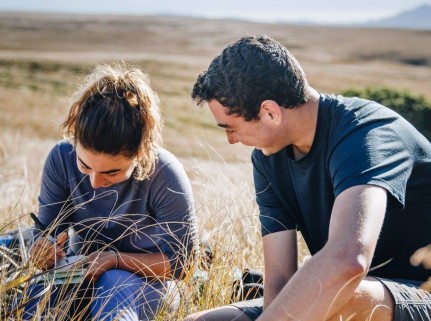It's one of our most frequently asked questions, 'What's the accommodation like on program?' And we're here to tell you what you can expect. Diversity is key in life. We embrace this idea while traveling overland across the world.
The place you lay your head at night is so much more than that. It’s an opportunity for connection and learning. Whilst on a program, you will experience a number of accommodation types. You will always be safe and comfortable. Accommodation is well thought out and planned to make the most of the area visited. From a sacred marae in New Zealand to a community homestay in rural Nepal, the places you stay on program are what give so much depth to the travel experience. Typically, we move from place to place every couple days. There are some locations, however, where you will settle in for longer such as during service learning projects.
There is quite a bit of variation depending on regions traveled. For example, on the Southeast Asia program you will immerse in the culture by participating in homestay experiences. If you’re on the Australia and New Zealand program, the homes are quite similar to your own region. Therefore, the way to get immersed is to go camping in the wilderness, which invites a whole different type of (environmental!) immersion.
Leaving your bedroom behind can be daunting, but here’s some more info to get you mentally prepared on what life on the road looks like.

Homestays
On the Central America, Asia and Pacific Island programs, homestays are a key part of the cultural immersion experience. Over many years, Pacific Discovery has developed relationships with operators which allow us the privilege of being invited into local homes. Lot of thought has gone into making the experience as comfortable as possible. People do live much more simply, so the program instructors will brief you on what to pack and expect beforehand. The group will be broken down into small groups and placed into homes of local people. There will probably be a language barrier, but the families have had experience hosting foreign guests before. Amazingly, the language barrier doesn’t hinder the experience. You will get a bed in a simple guest room, shared with your peers. The family will sleep in their own rooms, and they will go about their daily routines while you are there. The idea is to live like a local.
Snapshot for a homestay in Waling, Nepal:
You wake up to the sound of a rooster instead of an iPhone alarm, and sunlight breaking through the cracks in the simple wooden house. You’ve got a comfy little pillow and the comfort of your own sleeping bag. There’s a mosquito net over your bed, and you look around at the other two group members slowly waking up on their mattresses on the floor. Your duffel bag is next to you, with all of your gear neatly laid out against the wall and on a bedside table. You’re here for 10 days, so it’s nice to unpack and have everything handy and easy to see. It’s incredibly safe, and the community's top priority is your wellness. You’re beginning to notice those overly bright coloured blankets are a classic item in every Asian home. You can hear the family downstairs, but take some time to journal and stretch before heading down. The water buffalo is kept in the stable next door, and you can hear the house kids heading out to tend to them. In the kitchen, you’re politely asked to help pound chapati and roll it into balls for your breakfast. Everyone is calm and humble, going about their morning routine. There is not much furniture or belongings, but everything is kept neat and tidy inside the mud-brick home. You sit down cross legged to share potato curry with chapati bread and the best pickled chili of all time. Your instructors are two doors down to the left. You head out to meet the rest of the group in the village center, and the day is filled with bridge-making and hiking in the mountains. At lunch, one of the houses in the community has offered to make Dahl baht for the whole group. Rice and Dahl, potato curry, spinach and pickle with a crunchy pappadam. The Nepalese eat Dahl baht twice a day, every day of the year! After another huge and fulfilling day in the community, you head home to play with the kids, have a simple dinner and fall asleep without the distractions of home.
Camping
On most of our programs, there is a camping component. This is intentional, and adds so much to the fun. It’s a great way to get deep in nature, away from the noise and keep it really simple. We think some of the best sleeps we’ve ever had are while out camping! It’s easier to set your body with the sun, and get away from all those distractions. You can read a whole book by torchlight in just a few days when there’s no WIFI to entice you. And there’s nothing better than unzipping the tent to a gorgeous sunrise over mountains or sea.

Snapshot while camping on the Noosa Everglades Canoe Journey in Australia:
We pack the tents into our Canadian canoe barrels, making sure we don’t forget a sleeping mat, sleeping bag and something to use as a pillow. It’s good to put everything into a rubbish bag just to give it that extra layer of waterproofing. Add the food and sunscreen and cooking gear - and off we go! We are self sufficient for the next three days! After having a wildly fun day out in the sunshine, paddling and splashing through the narrow maze of Everglades, we arrive at camp. The instructors give us a thorough explanation of how to put up the tents. We break into pairs, some of us are already super familiar with camping. All of a sudden, there’s six little domes popped up on the riverside. We get really good at tying out the pegs so the wind doesn’t knock over the tents. Making the bed in the tent is a bit of an art - make the pillow really comfy so that you get that extra comfort level. And wear a face mask to keep out the light of the full moon! You will learn the little tips and tricks about what you like to have while camping. A face wipe to get rid of the zinc, dark chocolate in the pocket near your head, leaving your head-torch charging on a portable battery while you’re out for the day. These programs are the place to learn how to camp, so that you can go forward and feel comfortable to do it anywhere in the world!
Sometimes the tents are semi-permanent or fixed. Sometimes we pack them up small and take them with us in our hiking packs. Sometimes we have our group van right by the tents. We use camping equipment and stoves to make dinner, and learn everything about campcraft. These are awesome, transferable skills.
Hostels
These feature in almost all of our programs across the globe. Hostels are designed for the traveler; they are a place to make connections with people and activities in the area. At hostels, you can either stay in a shared room with 4-14 people. The great thing about hostels while traveling around the globe is that they make accommodation affordable, because traveling exclusively in hotels would most likely blow most budgets! Some are unbelievably creative and some are just kind of.. drab. So keep on exploring to find the best of the best! We’ve handpicked some of our favorites on Pacific Discovery programs.
Snapshot of a hostel in Queenstown, New Zealand.
You’ve just checked into the Black Sheep Hostel after rock climbing camp in Wanaka, and the captain of the day goes up to the hostel desk. You know the drill, you’ve all stayed in plenty of unique hostels across the country by now. The people at the front desk couldn’t be more helpful. They have information about what to do in town, and tips for restaurants and add personal touches about their favorite places to go. They hand out keys and show you the laundry, kitchen, lounge room and share the WIFI information. This hostel is a bit fancy - it’s even got a sauna and spa! The captain of the day breaks the groups of 4, and everyone heads to their room. We don’t share rooms with other travelers, only the other people in our group. We always mix it up to keep that diversity and fluidity amongst our group. The rooms have 2 bunk beds, and enough space to spread out our gear. Once we’ve showered and changed, we head to the group kitchen to prepare dinner for the crew. There are other travelers in the kitchen, making the atmosphere energetic and informative while we chop tomatoes for the greek salad. There are lots of choices for places to eat dinner; around shared tables or maybe on couches in a cozy and warm shared space. You might find yourself speaking with a fellow globe trotter and jotting down phone notes on places you must visit in Europe or eat in Christchurch next week. You also have valuable information for them, so the transaction is special for everyone. Hostels are often memorable with lots of character.
Other Types of Accommodation
We’ve all stayed in hotels and lodges. These are quite a typical form of accommodation for us in cities across the world. Typically, rooms are single beds shared between two or three group members. Normally an ensuite is attached to the room, but sometimes the bathroom is shared with other guests. Other accommodations on programs include Airbnbs and shared group spaces where the entire group sleep in one large room.

Leave a Comment
Your email address will not be published. Required fields are marked *